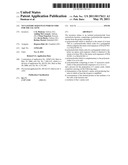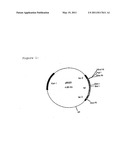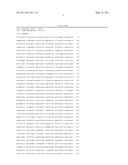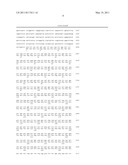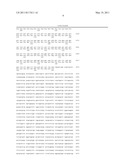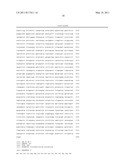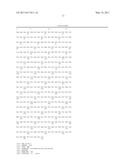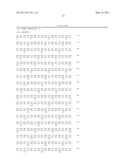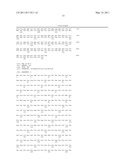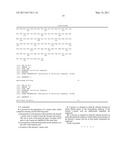Patent application title: Nucleotide Sequences Which Code for the tal Gene
Inventors:
L K. Dunican (Galway, IE)
Ashling Mccormack (Athlone, IE)
Cliona Stapelton (Roscrea, IE)
Kevin Burke (Galway, IE)
Bettina Mockel (Bielefeld, DE)
Assignees:
Degussa-Huls AG
IPC8 Class: AC12P1304FI
USPC Class:
435106
Class name: Chemistry: molecular biology and microbiology micro-organism, tissue cell culture or enzyme using process to synthesize a desired chemical compound or composition preparing alpha or beta amino acid or substituted amino acid or salts thereof
Publication date: 2011-05-19
Patent application number: 20110117611
Claims:
1-7. (canceled)
8. A process for the preparation of L-amino acids, which comprises carrying out the following steps: a) fermentation of the bacteria which produce the desired L-amino acid, in which at least the tal gene and optionally one or more of the genes tkt gene, zwt gene, devB gene or opcA gene are amplified at the same time, b) concentration of the desired product in the medium or in the cells of the bacteria and c) isolation of the desired L-amino acid.
9. A process as claimed in claim 8, wherein bacteria in which further genes of the biosynthesis pathway of the desired L-amino acid are additionally amplified are employed.
10. A process as claimed in claim 8, wherein bacteria in which the metabolic pathways which reduce the formation of the desired L-amino acid are at least partly eliminated are employed.
11-16. (canceled)
Description:
[0001] The invention provides nucleotide sequences which code for the tal
gene and a process for the fermentative preparation of amino acids, in
particular L-lysine, L-threonine, L-isoleucine and L-tryptophan, using
coryneform bacteria in which the tal gene is amplified.
PRIOR ART
[0002] Amino acids, in particular L-lysine, are used in human medicine and in the pharmaceuticals industry, but in particular in animal nutrition.
[0003] It is known that amino acids are prepared by fermentation by strains of coryneform bacteria, in particular Corynebacterium glutamicum. Because of their great importance, work is constantly being undertaken to improve the preparation processes. Improvements to the processes can relate to fermentation measures, such as e.g. stirring and supply of oxygen, or the composition of the nutrient media, such as e.g. the sugar concentration during the fermentation, or the working up to the product form by e.g. ion exchange chromatography, or the intrinsic output properties of the microorganism itself.
[0004] Methods of mutagenesis, selection and mutant selection are used to improve the output properties of these microorganisms. Strains which are resistant to antimetabolites, such as e.g. the lysine analogue S-(2-aminoethyl)-cysteine, or are auxotrophic for metabolites of regulatory importance and produce L-amino acids, such as e.g. L-lysine, are obtained in this manner.
[0005] Methods of the recombinant DNA technique have also been employed for some years for improving the strain of Corynebacterium strains which produce amino acids, by amplifying individual amino acid biosynthesis genes and investigating the effect on the amino acid production.
[0006] Review articles in this context are to be found, inter alia, in Kinoshita ("Glutamic Acid Bacteria", in: Biology of Industrial Microorganism's, Demain and Solomon (Eds.), Benjamin Cummings, London, UK, 1985, 115-142), Hilliger (BioTec 2, 40-44 (1991)), Eggeling (Amino Acids 6:261-272 (1994)), Jetten and Sinskey (Critical Reviews in Biotechnology 15, 73-103 (1995)) and Sahm et al. (Annuals of the New York Academy of Science 782, 25-39 (1996)).
[0007] The importance of the pentose phosphate cycle for the biosynthesis and production of amino acids, in particular L-lysine, by coryneform bacteria is the subject of numerous efforts among experts.
[0008] Thus Oishi and Aida (Agricultural and Biological Chemistry 29, 83-89 (1965)) report on the "hexose monophosphate shunt" of Brevibacterium ammoniagenes. Sugimoto and Shio (Agricultural and Biological [sic] Chemistry 51, 101-108 (1987)) report on the regulation of glucose 6-phosphate dehydrogenase in Brevibacterium flavum.
OBJECT OF THE INVENTION
[0009] The inventors had the object of providing new measures for improved fermentative preparation of amino acids, in particular L-lysine, L-threonine, L-isoleucine and L-tryptophan.
DESCRIPTION OF THE INVENTION
[0010] Amino acids, in particular L-lysine, are used in human medicine, in the pharmaceuticals industry and in particular in animal nutrition. There is therefore a general interest in providing new improved processes for the preparation of amino acids, in particular L-lysine.
[0011] When L-lysine or lysine are mentioned in the following, not only the base but also the salts, such as e.g. lysine monohydrochloride or lysine sulfate, are also meant by this.
[0012] The invention provides an isolated polynucleotide from coryneform bacteria, comprising a polynucleotide sequence chosen from the group consisting of [0013] a) polynucleotide which is identical to the extent of at least 70% to a polynucleotide which codes for a polypeptide which comprises the amino acid sequences of SEQ ID NO. 2 or SEQ ID NO. 4, [0014] b) polynucleotide which codes for a polypeptide which comprises an amino acid sequence which is identical to the extent of at least 70% to the amino acid sequences of SEQ ID NO. 2 or SEQ ID NO. 4, [0015] c) polynucleotide which is complementary to the polynucleotides of a) or b) and [0016] d) polynucleotide comprising at least 15 successive nucleotides of the polynucleotide sequence of a), b) or c).
[0017] The invention also provides the polynucleotide as claimed in claim 1, this preferably being a DNA which is capable of replication, comprising: [0018] (i) a nucleotide sequence chosen from the group consisting of SEQ ID NO. 1 and SEQ ID NO. 3 or [0019] (ii) at least one sequence which corresponds to sequence (i) within the range of the degeneration of the genetic code, or [0020] (iii) at least one sequence which hybridizes with the sequence complementary to sequence (i) or (ii), and optionally [0021] (iv) sense mutations of neutral function in (i).
[0022] The invention also provides [0023] a polynucleotide as claimed in claim 4, comprising one of the nucleotide sequences as shown in SEQ ID NO. 1 and SEQ ID NO. 3, [0024] a polynucleotide as claimed in claim 5, which codes for a polypeptide which comprises the amino acid sequence as shown in SEQ ID NO. 2 and SEQ ID NO. 4, [0025] a vector containing the polynucleotide as claimed in claim 1, [0026] and coryneform bacteria, serving as the host cell, which contain the vector.
[0027] The invention also provides polynucleotides which substantially comprise a polynucleotide sequence, which are [sic] obtainable by screening by means of hybridization of a corresponding gene library, which comprises the complete gene with the polynucleotide sequence corresponding to SEQ ID NO. 1 or SEQ ID NO. 3, with a probe which comprises the sequence of the polynucleotide mentioned, according to SEQ ID NO. 1 or SEQ ID NO. 3 or a fragment thereof, and isolation of the DNA sequence mentioned.
[0028] Polynucleotide sequences according to the invention are suitable as hybridization probes for RNA, cDNA and DNA, in order to isolate, in the full length, cDNA which code for transaldolase and to isolate those cDNA or genes which have a high similarity of sequence with that of the transaldolase gene.
[0029] Polynucleotide sequences according to the invention are furthermore suitable as primers for the preparation of DNA of genes which code for transaldolase by the polymerase chain reaction (PCR).
[0030] Such oligonucleotides which serve as probes or primers comprise at least 30, preferably at least 20, especially preferably at least 15 successive nucleotides. Oligonucleotides which have a length of at least 40 or 50 nucleotides are also suitable.
[0031] "Isolated" means separated out of its natural environment.
[0032] "Polynucleotide" in general relates to polyribonucleotides and polydeoxyribonucleotides, it being possible for these to be non-modified RNA or DNA or modified RNA or DNA.
[0033] "Polypeptides" is understood as meaning peptides or proteins which comprise two or more amino acids bonded via peptide bonds.
[0034] The polypeptides according to the invention include a polypeptide according to SEQ ID NO. 2 or SEQ ID NO. 4, in particular those with the biological activity of transaldolase, and also those which are identical to the extent of at least 70% to the polypeptide according to SEQ ID NO. 2 or SEQ ID NO. 4, and preferably are identical to the extent of at least 80% and in particular to the extent of at least 90% to 95% to the polypeptide according to SEQ ID NO. 2 or SEQ ID NO. 4, and have the activity mentioned.
[0035] The invention also provides a process for the fermentative preparation of amino acids, in particular L-lysine, L-threonine, L-isoleucine and L-tryptophan, using coryneform bacteria which in particular already produce an amino acid, and in which the nucleotide sequences which code for the tal gene are amplified, in particular over-expressed.
[0036] The term "amplification" in this connection describes the increase in the intracellular activity of one or more enzymes in a microorganism which are coded by the corresponding DNA, for example by increasing the number of copies of the gene or genes, using a potent promoter or using a gene which codes for a corresponding enzyme having a high activity, and optionally combining these measures.
[0037] The microorganisms which the present invention provides can prepare L-amino acids, in particular L-lysine, from glucose, sucrose, lactose, fructose, maltose, Molasses, starch, cellulose or from glycerol and ethanol. They can be representatives of coryneform bacteria, in particular of the genus Corynebacterium. Of the genus Corynebacterium, there may be mentioned in particular the species Corynebacterium glutamicum, which is known among experts for its ability to produce L-amino acids.
[0038] Suitable strains of the genus Corynebacterium, in particular of the species Corynebacterium glutamicum, are, for example, the known wild-type strains [0039] Corynebacterium glutamicum ATCC13032 [0040] Corynebacterium acetoglutamicum ATCC15806 [0041] Corynebacterium acetoacidophilum ATCC13870 [0042] Corynebacterium thermoaminogenes FERM BP-1539 [0043] Corynebacterium melassecola ATCC17965 [0044] Brevibacterium flavum ATCC14067 [0045] Brevibacterium lactofermentum ATCC13869 and [0046] Brevibacterium divaricatum ATCC14020 and L-lysine-producing mutants or strains prepared therefrom, such as, for example [0047] Corynebacterium glutamicum FERM-P 1709 [0048] Brevibacterium flavum FERM-P 1708 [0049] Brevibacterium lactofermentum FERM-P 1712 [0050] Corynebacterium glutamicum FERM-P 6463 [0051] Corynebacterium glutamicum FERM-P 6464 and [0052] Corynebacterium glutamicum ATCC13032 [0053] Corynebacterium glutamicum DM58-1 [0054] Corynebacterium glutamicum DSM12866. and L-threonine-producing mutants or strains prepared therefrom, such as, for example [0055] Corynebacterium glutamicum ATCC21649 [0056] Brevibacterium flavum BB69 [0057] Brevibacterium flavum DSM5399 [0058] Brevibacterium lactofermentum FERM-BP 269 [0059] Brevibacterium lactofermentum TBB-10 and L-isoleucine-producing mutants or strains prepared therefrom, such as, for example [0060] Corynebacterium glutamicum ATCC 14309 [0061] Corynebacterium glutamicum ATCC 14310 [0062] Corynebacterium glutamicum ATCC 14311 [0063] Corynebacterium glutamicum ATCC 15168 [0064] Corynebacterium ammoniagenes ATCC 6871 and L-tryptophan-producing mutants or strains prepared therefrom, such as, for example [0065] Corynebacterium glutamicum ATCC21850 and [0066] Corynebacterium glutamicum KY9218 (pKW9901)
[0067] The inventors have succeeded in isolating the new tal gene of C. glutamicum which codes for transaldolase (EC 2.2.1.2).
[0068] To isolate the tal gene or also other genes of C. glutamicum, a gene library of this microorganism is first set up in E. coli. The setting up of gene libraries is described in generally known textbooks and handbooks. The textbook by Winnacker: Gene and Klone, Eine Einfuhrung in die Gentechnologie [Genes and Clones, An Introduction to Genetic Engineering] (Verlag Chemie, Weinheim, Germany, 1990) or the handbook by Sambrook et al.: Molecular Cloning, A Laboratory Manual (Cold Spring Harbor Laboratory Press, 1989) may be mentioned as an example. A well-known gene library is that of the E. coli K-12 strain W3110 set up in λ vectors by Kohara et al. (Cell 50, 495-508 (1987)). Bathe et al. (Molecular and General Genetics, 252:255-265, 1996) describe a gene library of C. glutamicum ATCC13032, which was set up with the aid of the cosmid vector SuperCos I (Wahl et al., 1987, Proceedings of the National Academy of Sciences USA, 84:2160-2164) in the E. coli K-12 strain NM554 (Raleigh et al., 1988, Nucleic Acids Research 16:1563-1575). Bormann et al. (Molecular Microbiology 6(3), 317-326)) (1992)) in turn describe a gene library of. C. glutamicum ATCC13032 using the cosmid pHC79 (Hohn and Collins, Gene 11, 291-298 (1980)). O'Donohue (The Cloning and Molecular Analysis of Four Common Aromatic Amino Acid Biosynthetic Genes from Corynebacterium glutamicum. Ph.D. Thesis, National University of Ireland, Galway, 1997) describes the cloning of C. glutamicum genes using the λ Zap expression system described by Short et al. (Nucleic Acids Research, 16: 7583). To prepare a gene library of C. glutamicum in E. coli it is also possible to use plasmids such as pBR322 (Bolivar, Life Sciences, 25, 807-818 (1979)) or pUC9 (Vieira et al., 1982, Gene, 19:259-268). Suitable hosts are, in particular, those E. coli strains which are restriction- and recombination-defective. An example of these is the strain DH5αmcr, which has been described by Grant et al. (Proceedings of the National Academy of Sciences USA, 87 (1990) 4645-4649). The long DNA fragments cloned with the aid of cosmids can then in turn be subcloned and subsequently sequenced in the usual vectors which are suitable for sequencing, such as is described e.g. by Sanger et al. (Proceedings of the National Academy of Sciences of the United States of America, 74:5463-5467, 1977).
[0069] The DNA sequences obtained can then be investigated with known algorithms or sequence analysis programs, such as e.g. that of Staden (Nucleic Acids Research 14, 217-232 (1986)), the GCG program of Butler (Methods of Biochemical Analysis 39, 74-97 (1998)) the FASTA algorithm of Pearson and Lipman (Proceedings of the National Academy of Sciences USA 85, 2444-2448 (1988)) or the BLAST algorithm of Altschul et al. (Nature Genetics 6, 119-129 (1994)) and compared with the sequence entries which exist in databanks accessible to the public. Databanks for nucleotide sequences which are accessible to the public are, for example, that of the European Molecular Biologies Laboratories (EMBL, Heidelberg, Germany) of that of the National Center for Biotechnology Information (NCBI, Bethesda, Md., USA).
[0070] The invention provides the new DNA sequence from C. glutamicum which contains the DNA section which codes for the tal gene, shown as SEQ ID NO 1 and SEQ ID NO 3. The amino acid sequence of the corresponding protein has furthermore been derived from the present DNA sequence using the methods described above. The resulting amino acid sequence of the tal gene product is shown in SEQ ID NO 2 and SEQ ID NO 4.
[0071] A gene library produced in the manner described above can furthermore be investigated by hybridization with nucleotide probes of known sequence, such as, for example, the zwf gene (JP-A-09224661). The cloned DNA of the clones which show a positive reaction in the hybridization is sequenced in turn to give on the one hand the known nucleotide sequence of the probe employed and on the other hand the adjacent new DNA sequences.
[0072] Coding DNA sequences which result from SEQ ID NO 3 by the degeneracy of the genetic code are also a constituent of the invention. In the same way, DNA sequences which hybridize with SEQ ID NO 3 or parts of or [sic] SEQ ID NO 3 are a constituent of the invention. Conservative amino acid exchanges, such as e.g. exchange of glycine for alanine or of aspartic acid for glutamic acid in proteins, are furthermore known among experts as "sense mutations" which do not lead to a fundamental change in the activity of the protein, i.e. are of neutral function. It is furthermore known that changes on the N and/or C terminus of a protein cannot substantially impair or can even stabilize the function thereof. Information in this context can be found by the expert, inter alia, in Ben-Bassat et al. (Journal of Bacteriology 169:751-757 (1987)), in O'Regan et al. (Gene 77:237-251 (1989)), in Sahin-Toth et al. (Protein Sciences 3:240-247 (1994)), in Hochuli et al. (Bio/Technology 6:1321-1325 (1988)) and in known textbooks of genetics and molecular biology. Amino acid sequences which result in a corresponding manner from SEQ ID NO 2 or SEQ ID NO 4 are also a constituent, of the invention.
[0073] In the same way, DNA sequences which hybridize with or [sic] SEQ ID NO 3 or parts of or [sic] SEQ ID NO 3 are a constituent of the invention. Finally, DNA sequences which are prepared by the polymerase chain reaction (PCR) using primers which result from SEQ ID NO 3 are a constituent of the invention. Such oligonucleotides typically have a length of at least 15 nucleotides.
[0074] Instructions for identifying DNA sequences by means of hybridization can be found by the expert, inter alia, in the handbook "The DIG System Users Guide for Filter Hybridization" from Boehringer Mannheim GmbH (Mannheim, Germany, 1993) and in Liebl et al. (International Journal of Systematic Bacteriology (1991) 41: 255-260). Instructions for amplification of DNA sequences with the aid of the polymerase chain reaction (PCR) can be found by the expert, inter alia, in the handbook by Gait: Oligonukleotide [sic] synthesis: a practical approach (IRL Press, Oxford, UK, 1984) and in Newton and Graham: PCR (Spektrum Akademischer Verlag, Heidelberg, Germany, 1994).
[0075] The inventors have found that coryneform bacteria produce amino acids in an improved manner after over-expression of the tal gene.
[0076] To achieve an over-expression, the number of copies of the corresponding genes can be increased, or the promoter and regulation region or the ribosome binding site upstream of the structural gene can be mutated. Expression cassettes which are incorporated upstream of the structural gene act in the same way. By inducible promoters, it is additionally possible to increase the expression in the course of fermentative L-amino acid production. The expression is likewise improved by measures to prolong the life of the mRNA. Furthermore, the enzyme activity is also increased by preventing the degradation of the enzyme protein. The genes or gene constructs can either be present in plasmids with a varying number of copies, or can be integrated and amplified in the chromosome. Alternatively, an over-expression of the genes in question can furthermore be achieved by changing the composition of the media and the culture procedure.
[0077] Instructions in this context can be found by the expert, inter alia, in Martin et al. (Bio/Technology 5, 137-146 (1987)), in Guerrero et al. (Gene 138, 35-41 (1994)), Tsuchiya and Morinaga (Bio/Technology 6, 428-430 (1988)), in Eikmanns et al. (Gene 102, 93-98 (1991)), in European Patent Specification EPS 0 472 869, in U.S. Pat. No. 4,601,893, in Schwarzer and Puhler (Bio/Technology 9, 84-87 (1991), in Reinscheid et al. (Applied and Environmental Microbiology 60, 126-132 (1994)), in LaBarre et al. (Journal of Bacteriology 175, 1001-1007 (1993)), in Patent Application WO 96/15246, in Malumbres et al. (Gene 134, 15-24 (1993)), in Japanese Laid-Open Specification JP-A-10-229891, in Jensen and Hammer (Biotechnology and Bioengineering 58, 191-195 (1998)), in Makrides (Microbiological Reviews 60:512-538 (1996)) and in known textbooks of genetics and molecular biology.
[0078] By way of example, the tal gene according to the invention was over-expressed with the aid of plasmids.
[0079] Suitable plasmids are those which are replicated in coryneform bacteria. Numerous known plasmid vectors, such as e.g. pZ1 (Menkel et al., Applied and Environmental Microbiology (1989) 64: 549-554), pEKEx1 (Eikmanns et al., Gene 102:93-98 (1991)) or pHS2-1 (Sonnen et al., Gene 107:69-74 (1991)) are based on the cryptic plasmids pHM1519, pBL1 or pGA1. Other plasmid vectors, such as e.g. those based on pCG4 (U.S. Pat. No. 4,489,160), or pNG2 (Serwold-Davis et al., FEMS Microbiology Letters 66, 119-124 (1990)), or pAG1 (U.S. Pat. No. 5,158,891), can be used in the same manner.
[0080] Plasmid vectors which are furthermore suitable are also those with the aid of which the process of gene amplification by integration into the chromosome can be used, as has been described, for example, by Reinscheid et al. (Applied and Environmental Microbiology 60, 126-132 (1994)) for duplication or amplification of the hom-thrB operon. In this method, the complete gene is cloned in a plasmid vector which can replicate in a host (typically E. coli), but not in C. glutamicum. Possible vectors are, for example, pSUP301 (Simon et al., Bio/Technology 1, 784-791 (1983)), pK18mob or pK19mob (Schafer et al., Gene 145, 69-73 (1994)), pGEM-T (Promega corporation [sic], Madison, Wis., USA), pCR2.1-TOPO (Shuman (1994). [sic] Journal of Biological Chemistry 269:32678-84; U.S. Pat. No. 5,487,993), pCR® Blunt (Invitrogen, Groningen, Holland; Bernard et al., Journal of Molecular Biology, 234: 534-541 (1993)), pEM1 (Schrumpf et al, 1991, Journal of Bacteriology 173:4510-4516) or pBGS8 (Spratt et al., 1986, Gene 41:337-342). The plasmid vector which contains the gene to be amplified is then transferred into the desired strain of C. glutamicum by conjugation or transformation. The method of conjugation is described, for example, by Schafer et al. (Applied and Environmental Microbiology 60, 756-759 (1994)). Methods for transformation are described, for example, by Thierbach et al. (Applied Microbiology and Biotechnology 29, 356-362 (1988)), Dunican and Shivnan (Bio/Technology 7, 1067-1070 (1989)) and Tauch et al. (FEMS Microbiological Letters 123, 343-347 (1994)). After homologous recombination by means of a "cross over" event, the resulting strain contains at least two copies of the gene in question.
[0081] An example of a plasmid vector with the aid of which the process of amplification by integration can be carried out is pSUZ1, which is shown in FIG. 1. Plasmid pSUZ1 consists of the E. coli vector pBGS8 described by Spratt et al. (Gene 41: 337-342 (1986)), into which the tal gene has been incorporated.
[0082] In addition, it may be advantageous for the production of amino acids to amplify or over-express one or more enzymes of the particular biosynthesis pathway, of glycolysis, of anaplerosis, of the pentose phosphate pathway or of amino acid export, in addition to the tal gene.
[0083] Thus, for example, for the preparation of L-amino acids, in particular L-lysine, one or more genes chosen from the group consisting of [0084] the dapA gene which codes for dihydrodipicolinate synthase (EP-B 0 197 335), [0085] the lysC gene which codes for a feed back resistant aspartate kinase (Kalinowski et al. (1990), Molecular and General Genetics 224: 317-324), [0086] the gap gene which codes for glycerolaldehyde 3-phosphate dehydrogenase (Eikmanns (1992), Journal of Bacteriology 174:6076-6086), [0087] the pyc gene which codes for pyruvate carboxylase (DE-A-198 31 609), [0088] the mqo gene which codes for malate:quinone oxidoreductase (Molenaar et al., European Journal of Biochemistry 254, 395-403 (1998)), [0089] the tkt gene which codes for transketolase (accession number AB023377 of the databank of European Molecular Biologies Laboratories (EMBL, Heidelberg, Germany)), [0090] the gnd gene which codes for 6-phosphogluconate dehydrogenase (JP-A-9-224662), [0091] the zwf gene which codes for glucose 6-phosphate dehydrogenase (JP-A-9-224661), [0092] the lysE gene which codes for lysine export (DE-A-195 48 222), [0093] the zwa1 gene (DE 199 59 328.0; DSM 13115), [0094] the eno gene which codes for enolase (DE: 19947791.4), [0095] the devB gene, [0096] the opcA gene (DSM 13264) can be amplified, preferably over-expressed, at the same time.
[0097] Thus, for example, for the preparation of L-threonine, one or more genes chosen from the group consisting of [0098] at the same time the hom gene which codes for homoserine dehydrogenase (Peoples et al., Molecular Microbiology 2, 63-72 (1988)) or the homdr allele which codes for a "feed back resistant" homoserine dehydrogenase (Archer et al., Gene 107, 53-59 (1991), [0099] the gap gene which codes for glycerolaldehyde 3-phosphate dehydrogenase (Eikmanns (1992), Journal of Bacteriology 174:6076-6086), [0100] the pyc gene which codes for pyruvate carboxylase (DE-A-198 31 609), [0101] the mqo gene which codes for malate:quinone oxidoreductase (Molenaar et al., European Journal of Biochemistry 254, 395-403 (1998)), [0102] the tkt gene which codes for transketolase (accession number AB023377 of the databank of European Molecular Biologies Laboratories (EMBL, Heidelberg, Germany)), [0103] the gnd gene which codes for 6-phosphogluconate dehydrogenase (JP-A-9-224662), [0104] the zwf gene which codes for glucose 6-phosphate dehydrogenase (JP-A-9-224661), [0105] the thrE gene which codes for threonine export (DE 199 41 478.5; DSM 12840), [0106] the zwa1 gene (DE 199 59 328.0; DSM 13115), [0107] the eno gene which codes for enolase (DE: 19947791.4), [0108] the devB gene, [0109] the opcA gene (DSM 13264) can be amplified, preferably over-expressed, at the same time . . . [sic]
[0110] It may furthermore be advantageous for the production of amino acids to attenuate [0111] the pck gene which codes for phosphoenol pyruvate carboxykinase (DE 199 50 409.1 DSM 13047) and/or [0112] the pgi gene which codes for glucose 6-phosphate isomerase (U.S. Ser. No. 09/396,478, DSM 12969), or [0113] the poxB gene which codes for pyruvate oxidase (DE 199 51 975.7; DSM 13114), or [0114] the zwa2 gene (DE: 199 59 327.2; DSM 13113) at the same time, in addition to the amplification of the tal gene.
[0115] In addition to over-expression of the tal gene it may furthermore be advantageous for the production of amino acids to eliminate undesirable side reactions (Nakayama: "Breeding of Amino Acid Producing Micro-organisms", in: Overproduction of Microbial Products, Krumphanzl, Sikyta, Vanek (eds.), Academic Press, London, UK, 1982).
[0116] The microorganisms prepared according to the invention can be cultured continuously or discontinuously in the batch process (batch culture) or in the fed batch (feed process) or repeated fed batch process (repetitive feed process) for the purpose of production of L-amino acids. A summary of known culture methods are [sic] described in the textbook by Chmiel (Bioprozeβtechnik 1. Einfuhrung in die Bioverfahrenstechnik [Bioprocess Technology 1. Introduction to Bioprocess Technology (Gustav Fischer Verlag, Stuttgart, 1991)) or in the textbook by Storhas (Bioreaktoren and periphere Einrichtungen [Bioreactors and Peripheral Equipment] (Vieweg Verlag, Braunschweig/Wiesbaden, 1994)).
[0117] The culture medium to be used must meet the requirements of the particular strains in a suitable manner. Descriptions of culture media for various microorganisms are contained in the handbook "Manual of Methods for General Bacteriology" of the American Society for Bacteriology (Washington D.C., USA, 1981). Sugars and carbohydrates, such as e.g. glucose, sucrose, lactose, fructose, maltose, molasses, starch and cellulose, oils and fats, such as e.g. soya oil, sunflower oil, groundnut oil and coconut fat, fatty acids, such as e.g. palmitic acid, stearic acid and linoleic acid, alcohols, Such as e.g. glycerol and ethanol, and organic acids, such as e.g. acetic acid, can be used as the source of carbon. These substances can be used individually or as a mixture. Organic nitrogen-containing compounds, such as peptones, yeast extract, meat extract, malt extract, corn steep liquor, soya bean flour and urea, or inorganic compounds, such as ammonium sulphate, ammonium chloride, ammonium phosphate, ammonium carbonate and ammonium nitrate, can be used as the source of nitrogen. The sources of nitrogen can be used individually or as a mixture. Phosphoric acid, potassium dihydrogen phosphate or dipotassium hydrogen phosphate or the corresponding sodium-containing salts can be used as the source of phosphorus. The culture medium must furthermore comprise salts of metals, such as e.g. magnesium sulfate or iron sulfate, which are necessary for growth. Finally, essential growth substances, such as amino acids and vitamins, can be employed in addition to the abovementioned substances. Suitable precursors can moreover be added to the culture medium. The starting substances mentioned can be added to the culture in the form of a single batch, or can be fed in during the culture in a suitable manner.
[0118] Basic compounds, such as sodium hydroxide, potassium hydroxide, ammonia or aqueous ammonia, or acid compounds, such as phosphoric acid or sulfuric acid, can be employed in a suitable manner to control the pH of the culture. Antifoams, such as e.g. fatty acid polyglycol esters, can be employed to control the development of foam. Suitable substances having a selective action, such as e.g. antibiotics, can be added to the medium to maintain the stability of plasmids. To maintain aerobic conditions, oxygen or oxygen-containing gas mixtures, such as e.g. air, are introduced into the culture. The temperature of the culture is usually 20° C. to 45° C., and preferably 25° C. to 40° C. Culturing is continued until a maximum of L-amino acid has formed. This target is usually reached within 10 hours to 160 hours.
[0119] The analysis of L-amino acids can be carried out by anion exchange chromatography with subsequent ninhydrin derivatization, as described by Spackman et al. (Analytical Chemistry, 30, (1958), 1190).
[0120] The following microorganism has been deposited at the Deutsche Sammlung fur Mikrorganismen and Zellkulturen (DSMZ=German Collection of Microorganisms and Cell Cultures, Braunschweig, Germany) in accordance with the Budapest Treaty: [0121] Escherichia coli JM109/pSUZ1 as DSM 13263.
[0122] SEQ ID NO 1 also contains the new devB gene. The process according to the invention is used for fermentative preparation of amino acids.
[0123] The following figures are attached:
[0124] FIG. 1: Map of the plasmid pSUZ1
[0125] The abbreviations and designations used have the following meaning.
lacZ: segments of lacZα gene fragment kan r: kanamycin resistance tal: transaldolase gene ori: origin of replication of plasmid pBGS8 BclI: cleavage site of restriction enzyme BclI EcoRI: cleavage site of restriction enzyme EcoRI HindIII: cleavage site of restriction enzyme HindIII PstI: cleavage site of restriction enzyme PstI SacI: cleavage site of restriction enzyme SacI
EXAMPLES
[0126] The following examples will further illustrate this invention. The molecular biology techniques, e.g. plasmid DNA isolation, restriction enzyme treatment, ligations, standard transformations of Escherichia coli etc. used are, (unless stated otherwise), described by Sambrook et al., (Molecular Cloning. A Laboratory Manual (1989) Cold Spring Harbour Laboratories, USA).
Example 1
Preparation of a Genomic Cosmid Gene Library from Corynebacterium glutamicum ATCC 13032
[0127] Chromosomal DNA from Corynebacterium glutamicum ATCC 13032 was isolated as described by Tauch et al. (1995, Plasmid 33:168-179) and partly cleaved with the restriction enzyme Sau3AI (Amersham Pharmacia, Freiburg, Germany, Product Description Sau3AI, Code no. 27-0913-02). The DNA fragments were dephosphorylated with shrimp alkaline phosphatase (Roche Molecular Biochemicals, Mannheim, Germany, Product Description SAP, Code no. 1758250). The DNA of the cosmid vector SuperCos1 (Wahl et al. (1987) Proceedings of the National Academy of Sciences USA 84:2160-2164), obtained from Stratagene (La Jolla, USA, Product Description SuperCos1 Cosmid Vector Kit, Code no. 251301) was cleaved with the restriction enzyme XbaI (Amersham Pharmacia, Freiburg, Germany, Product Description XbaI, Code no. 27-0948-02) and likewise dephosphorylated with shrimp alkaline phosphatase. The cosmid DNA was then cleaved with the restriction enzyme BamHI (Amersham Pharmacia, Freiburg, Germany, Product Description BamHI, Code no. 27-0868-04). The cosmid DNA treated in this manner was mixed with the treated ATCC13032 DNA and the batch was treated with T4 DNA ligase (Amersham Pharmacia, Freiburg, Germany, Product Description T4-DNA-Ligase, Code no. 27-0870-04). The ligation mixture was then packed in phages with the aid of Gigapack II XL Packing Extracts (Stratagene, La Jolla, USA, Product Description Gigapack II XL Packing Extract, Code no. 200217). For infection of the E. coli strain NM554 (Raleigh et al. 1988, Nucleic Acid Research 16:1563-1575) the cells were taken up in 10 mM MgSO4 and mixed with an aliquot of the phage suspension. The infection and titering of the cosmid library were carried out as described by Sambrook et al. (1989, Molecular Cloning: A laboratory Manual, Cold Spring Harbor), the cells being plated out on LB agar (Lennox, 1955, Virology, 1:190) with 100 μg/ml ampicillin. After incubation overnight at 37° C., recombinant individual clones were selected.
Example 2
Isolation and Sequencing of the tal Gene
[0128] The cosmid DNA of an individual colony was isolated with the Qiaprep Spin Miniprep Kit (Product No. 27106, Qiagen, Hilden, Germany) in accordance with the manufacturer's instructions and partly cleaved with the restriction enzyme Sau3AI (Amersham Pharmacia, Freiburg, Germany, Product Description Sau3AI, Product No. 27-0913-02). The DNA fragments were dephosphorylated with shrimp alkaline phosphatase (Roche Molecular Biochemicals, Mannheim, Germany, Product Description SAP, Product No. 1758250). After separation by gel electrophoresis, the cosmid fragments in the size range of 1500 to 2000 bp were isolated with the QiaExII Gel Extraction Kit (Product No. 20021, Qiagen, Hilden, Germany). The DNA of the sequencing vector pZero-1, obtained from Invitrogen (Groningen, Holland, Product Description Zero Background Cloning Kit, Product No. K2500-01) was cleaved with the restriction enzyme BamHI (Amersham Pharmacia, Freiburg, Germany, Product Description BamHI, Product No. 27-0868-04). The ligation of the cosmid fragments in the sequencing vector pZero-1 was carried out as described by Sambrook et al. (1989, Molecular Cloning: A laboratory Manual, Cold Spring Harbor), the DNA mixture being incubated overnight with T4 ligase (Pharmacia Biotech, Freiburg, Germany). This ligation mixture was then electroporated (Tauch et al. 1994, FEMS Microbiol Letters, 123:343-7) into the E. coli strain DH5αMCR (Grant, 1990, Proceedings of the National Academy of Sciences U.S.A., 87:4645-4649) and plated out on LB agar (Lennox, 1955, Virology, 1:190) with 50 μg/ml zeocin. The plasmid preparation of the recombinant clones was carried out with Biorobot 9600 (Product No. 900200, Qiagen, Hilden, Germany). The sequencing was carried out by the dideoxy chain-stopping method of Sanger et al. (1977, Proceedings of the National Academy of Sciences U.S.A., 74:5463-5467) with modifications according to Zimmermann et al. (1990, Nucleic Acids Research, 18:1067). The "RR dRhodamin Terminator Cycle Sequencing Kit" from PE Applied Biosystems (Product No. 403044, Weiterstadt, Germany) was used. The separation by gel electrophoresis and analysis of the sequencing reaction were carried out in a "Rotiphoresis NF Acrylamide/Bisacrylamide" Gel (29:1) (Product No. A124.1, Roth, Karlsruhe, Germany) with the "ABI Prism 377" sequencer from PE Applied Biosystems (Weiterstadt, Germany).
[0129] The raw sequence data obtained were then processed using the Staden program package (1986, Nucleic Acids Research, 14:217-231) version 97-0: The individual sequences of the pZero1 derivatives were assembled to a continuous contig. The computer-assisted coding region analysis [sic] were prepared with the XNIP program (Staden, 1986, Nucleic Acids Research, 14:217-231). Further analyses were carried out with the "BLAST search program" (Altschul et al., 1997, Nucleic Acids Research, 25:3389-3402), against the non-redundant databank of the "National Center for Biotechnology Information" (NCBI, Bethesda, Md., USA). The nucleotide sequence obtained is shown in SEQ ID NO 1 and SEQ ID NO 3.
Example 3
Cloning of the tal Gene
[0130] PCR was used to amplify DNA fragments containing the entire tal gene of C. glutamicum 13032 and flanking upstream and downstream regions. PCR reactions were carried out using oligonucleotide primers designed from the sequence as determined in examples 1 and 2. Genomic DNA was isolated from Corynebacterium glutamicum ATCC13032 according to Heery and Dunican (Applied and Environmental Microbiology 59: 791-799 (1993)) and used as template. The tal primers used were:
fwd. primer: 5' GGT ACA AAG GGT CTT AAG 3'C rev. primer: 5' GAT TTC ATG TCG CCG TTA 3'
[0131] PCR Parameters were as follows: [0132] 35 cycles [0133] 95° C. for 0.3 minutes [0134] 94° C. for 1 minute [0135] 47° C. for 1 minute [0136] 72° C. for 45 seconds [0137] 2.0 mM MgCl2 [0138] approximately 150-200 ng DNA template.
[0139] The PCR product obtained was cloned into the commercially available pGEM-T vector purchased from Promega Corp. (pGEM-T Easy Vector System 1, cat. no. A1360, Promega UK, Southampton, UK) using strain E. coli JM109 (Yanisch-Perron et al., Gene, 33: 103-119 (1985)) as a host. The entire tal gene was subsequently isolated from the pGEM T-vector on an Eco RI fragment and cloned into the lacZα EcoRI site of the E. coli vector pBGS8 (Spratt et al., Gene 41(2-3): 337-342 (1986)). The restriction enzymes used were obtained from Boehringer Mannheim UK Ltd. (Bell Lane, Lewes East Sussex BN7 1LG, UK) and used according to manufacturer's instructions. E. coli JMI09 was then transformed with this ligation mixture and electrotransformants were selected on Luria agar supplemented with isopropyl-thiogalactopyranoside (IPTG), 5-bromo-4-chloro-3-indolyl-galactopyranoside (XGAL) and kanamycin at concentrations of 1 mM, 0.02% and 50 mg/l respectively. Plates were incubated for twelve hours at 37° C. Plasmid DNA was isolated from one transformant, characterised by restriction enzyme analysis using Eco RI. This new construct was designated pSUZ 1.
Sequence CWU
1
616995DNACorynebacterium glutamicumCDS(2471)..(3550)tal-Gen 1cacatttgaa
ccacagttgg ttataaaatg ggttcaacat cactatggtt agaggtgttg 60acgggtcaga
ttaagcaaag actactttcg gggtagatca cctttgccaa atttgaacca 120attaacctaa
gtcgtagatc tgatcatcgg atctaacgaa aacgaaccaa aactttggtc 180ccggtttaac
ccaggaagga ttgaccacct tgacgctgtc acctgaactt caggcgctca 240ctgtacgcaa
ttacccctct gattggtccg atgtggacac caaggctgta gacactgttc 300gtgtcctcgc
tgcagacgct gtagaaaact gtggctccgg ccacccaggc accgcaatga 360gcctggctcc
ccttgcatac accttgtacc agcgggttat gaacgtagat ccacaggaca 420ccaactgggc
aggccgtgac cgcttcgttc tttcttgtgg ccactcctct ttgacccagt 480acatccagct
ttacttgggt ggattcggcc ttgagatgga tgacctgaag gctctgcgca 540cctgggattc
cttgacccca ggacaccctg agtaccgcca caccaagggc gttgagatca 600ccactggccc
tcttggccag ggtcttgcat ctgcagttgg tatggccatg gctgctcgtc 660gtgagcgtgg
cctattcgac ccaaccgctg ctgagggcga atccccattc gaccaccaca 720tctacgtcat
tgcttctgat ggtgacctgc aggaaggtgt cacctctgag gcatcctcca 780tcgctggcac
ccagcagctg ggcaacctca tcgtgttctg ggatgacaac cgcatctcca 840tcgaagacaa
cactgagatc gctttcaacg aggacgttgt tgctcgttac aaggcttacg 900gctggcagac
cattgaggtt gaggctggcg aggacgttgc agcaatcgaa gctgcagtgg 960ctgaggctaa
gaaggacacc aagcgaccta ccttcatccg cgttcgcacc atcatcggct 1020tcccagctcc
aactatgatg aacaccggtg ctgtgcacgg tgctgctctt ggcgcagctg 1080aggttgcagc
aaccaagact gagcttggat tcgatcctga ggctcacttc gcgatcgacg 1140atgaggttat
cgctcacacc cgctccctcg cagagcgcgc tgcacagaag aaggctgcat 1200ggcaggtcaa
gttcgatgag tgggcagctg ccaaccctga gaacaaggct ctgttcgatc 1260gcctgaactc
ccgtgagctt ccagcgggct acgctgacga gctcccaaca tgggatgcag 1320atgagaaggg
cgtcgcaact cgtaaggctt ccgaggctgc acttcaggca ctgggcaaga 1380cccttcctga
gctgtggggc ggttccgctg acctcgcagg ttccaacaac accgtgatca 1440agggctcccc
ttccttcggc cctgagtcca tctccaccga gacctggtct gctgagcctt 1500acggccgtaa
cctgcacttc ggtatccgtg agcacgctat gggatccatc ctcaacggca 1560tttccctcca
cggtggcacc cgcccatacg gcggaacctt cctcatcttc tccgactaca 1620tgcgtcctgc
agttcgtctt gcagctctca tggagaccga cgcttactac gtctggaccc 1680acgactccat
cggtctgggc gaagatggcc caacccacca gcctgttgaa accttggctg 1740cactgcgcgc
catcccaggt ctgtccgtcc tgcgtcctgc agatgcgaac gagaccgccc 1800aggcttgggc
tgcagcactt gagtacaagg aaggccctaa gggtcttgca ctgacccgcc 1860agaacgttcc
tgttctggaa ggcaccaagg agaaggctgc tgaaggcgtt cgccgcggtg 1920gctacgtcct
ggttgagggt tccaaggaaa ccccagatgt gatcctcatg ggctccggct 1980ccgaggttca
gcttgcagtt aacgctgcga aggctctgga agctgagggc gttgcagctc 2040gcgttgtttc
cgttccttgc atggattggt tccaggagca ggacgcagag tacatcgagt 2100ccgttctgcc
tgcagctgtg accgctcgtg tgtctgttga agctggcatc gcaatgcctt 2160ggtaccgctt
cttgggcacc cagggccgtg ctgtctccct tgagcacttc ggtgcttctg 2220cggattacca
gaccctgttt gagaagttcg gcatcaccac cgatgcagtc gtggcagcgg 2280ccaaggactc
cattaacggt taattgccct gctgttttta gcttcaaccc ggggcaatat 2340gattctccgg
aattttattg ccccgggttg ttgttgttaa tcggtacaaa gggtcttaag 2400cacatccctt
acttgcctgc tctccttgag cacagttcaa gaacaattct tttaaggaaa 2460atttagtttc
atg tct cac att gat gat ctt gca cag ctc ggc act tcc 2509
Met Ser His Ile Asp Asp Leu Ala Gln Leu Gly Thr Ser 1
5 10act tgg ctc gac gac ctc tcc cgc gag cgc att act
tcc ggc aat ctc 2557Thr Trp Leu Asp Asp Leu Ser Arg Glu Arg Ile Thr
Ser Gly Asn Leu 15 20 25agc cag gtt
att gag gaa aag tct gta gtc ggt gtc acc acc aac cca 2605Ser Gln Val
Ile Glu Glu Lys Ser Val Val Gly Val Thr Thr Asn Pro30 35
40 45gct att ttc gca gca gca atg tcc
aag ggc gat tcc tac gac gct cag 2653Ala Ile Phe Ala Ala Ala Met Ser
Lys Gly Asp Ser Tyr Asp Ala Gln 50 55
60atc gca gag ctc aag gcc gct ggc gca tct gtt gac cag gct
gtt tac 2701Ile Ala Glu Leu Lys Ala Ala Gly Ala Ser Val Asp Gln Ala
Val Tyr 65 70 75gcc atg agc
atc gac gac gtt cgc aat gct tgt gat ctg ttc acc ggc 2749Ala Met Ser
Ile Asp Asp Val Arg Asn Ala Cys Asp Leu Phe Thr Gly 80
85 90atc ttc gag tcc tcc aac ggc tac gac ggc cgc
gtg tcc atc gag gtt 2797Ile Phe Glu Ser Ser Asn Gly Tyr Asp Gly Arg
Val Ser Ile Glu Val 95 100 105gac cca
cgt atc tct gct gac cgc gac gca acc ctg gct cag gcc aag 2845Asp Pro
Arg Ile Ser Ala Asp Arg Asp Ala Thr Leu Ala Gln Ala Lys110
115 120 125gag ctg tgg gca aag gtt gat
cgt cca aac gtc atg atc aag atc cct 2893Glu Leu Trp Ala Lys Val Asp
Arg Pro Asn Val Met Ile Lys Ile Pro 130
135 140gca acc cca ggt tct ttg cca gca atc acc gac gct
ttg gct gag ggc 2941Ala Thr Pro Gly Ser Leu Pro Ala Ile Thr Asp Ala
Leu Ala Glu Gly 145 150 155atc
agc gtt aac gtc acc ttg atc ttc tcc gtt gct cgc tac cgc gag 2989Ile
Ser Val Asn Val Thr Leu Ile Phe Ser Val Ala Arg Tyr Arg Glu 160
165 170gtc atc gct gcg ttc atc gag ggc atc
aag cag gct gct gca aac ggc 3037Val Ile Ala Ala Phe Ile Glu Gly Ile
Lys Gln Ala Ala Ala Asn Gly 175 180
185cac gac gtc tcc aag atc cac tct gtg gct tcc ttc ttc gtc tcc cgc
3085His Asp Val Ser Lys Ile His Ser Val Ala Ser Phe Phe Val Ser Arg190
195 200 205gtc gac gtt gag
atc gac aag cgc ctc gag gca atc gga tcc gat gag 3133Val Asp Val Glu
Ile Asp Lys Arg Leu Glu Ala Ile Gly Ser Asp Glu 210
215 220gct ttg gct ctg cgc ggc aag gca ggc gtt
gcc aac gct cag cgc gct 3181Ala Leu Ala Leu Arg Gly Lys Ala Gly Val
Ala Asn Ala Gln Arg Ala 225 230
235tac gct gtg tac aag gag ctt ttc gac gcc gcc gag ctg cct gaa ggt
3229Tyr Ala Val Tyr Lys Glu Leu Phe Asp Ala Ala Glu Leu Pro Glu Gly
240 245 250gcc aac act cag cgc cca ctg
tgg gca tcc acc ggc gtg aag aac cct 3277Ala Asn Thr Gln Arg Pro Leu
Trp Ala Ser Thr Gly Val Lys Asn Pro 255 260
265gcg tac gct gca act ctt tac gtt tcc gag ctg gct ggt cca aac acc
3325Ala Tyr Ala Ala Thr Leu Tyr Val Ser Glu Leu Ala Gly Pro Asn Thr270
275 280 285gtc aac acc atg
cca gaa ggc acc atc gac gcg gtt ctg gag cag ggc 3373Val Asn Thr Met
Pro Glu Gly Thr Ile Asp Ala Val Leu Glu Gln Gly 290
295 300aac ctg cac ggt gac acc ctg tcc aac tcc
gcg gca gaa gct gac gct 3421Asn Leu His Gly Asp Thr Leu Ser Asn Ser
Ala Ala Glu Ala Asp Ala 305 310
315gtg ttc tcc cag ctt gag gct ctg ggc gtt gac ttg gca gat gtc ttc
3469Val Phe Ser Gln Leu Glu Ala Leu Gly Val Asp Leu Ala Asp Val Phe
320 325 330cag gtc ctg gag acc gag ggt
gtg gac aag ttc gtt gct tct tgg agc 3517Gln Val Leu Glu Thr Glu Gly
Val Asp Lys Phe Val Ala Ser Trp Ser 335 340
345gaa ctg ctt gag tcc atg gaa gct cgc ctg aag tagaatcagc acgctgcatc
3570Glu Leu Leu Glu Ser Met Glu Ala Arg Leu Lys350 355
360agtaacggcg acatgaaatc gaattagttc gatcttatgt ggccgttaca
catctttcat 3630taaagaaagg atcgtgacac taccatcgtg agcacaaaca cgaccccctc
cagctggaca 3690aacccactgc gcgacccgca ggataaacga ctcccccgca tcgctggccc
ttccggcatg 3750gtgatcttcg gtgtcactgg cgacttggct cgaaagaagc tgctccccgc
catttatgat 3810ctagcaaacc gcggattgct gcccccagga ttctcgttgg taggttacgg
ccgccgcgaa 3870tggtccaaag aagactttga aaaatacgta cgcgatgccg caagtgctgg
tgctcgtacg 3930gaattccgtg aaaatgtttg ggagcgcctc gccgagggta tggaatttgt
tcgcggcaac 3990tttgatgatg atgcagcttt cgacaacctc gctgcaacac tcaagcgcat
cgacaaaacc 4050cgcggcaccg ccggcaactg ggcttactac ctgtccattc caccagattc
cttcacagcg 4110gtctgccacc agctggagcg ttccggcatg gctgaatcca ccgaagaagc
atggcgccgc 4170gtgatcatcg agaagccttt cggccacaac ctcgaatccg cacacgagct
caaccagctg 4230gtcaacgcag tcttcccaga atcttctgtg ttccgcatcg accactattt
gggcaaggaa 4290acagttcaaa acatcctggc tctgcgtttt gctaaccagc tgtttgagcc
actgtggaac 4350tccaactacg ttgaccacgt ccagatcacc atggctgaag atattggctt
gggtggacgt 4410gctggttact acgacggcat cggcgcagcc cgcgacgtca tccagaacca
cctgatccag 4470ctcttggctc tggttgccat ggaagaacca atttctttcg tgccagcgca
gctgcaggca 4530gaaaagatca aggtgctctc tgcgacaaag ccgtgctacc cattggataa
aacctccgct 4590cgtggtcagt acgctgccgg ttggcagggc tctgagttag tcaagggact
tcgcgaagaa 4650gatggcttca accctgagtc caccactgag acttttgcgg cttgtacctt
agagatcacg 4710tctcgtcgct gggctggtgt gccgttctac ctgcgcaccg gtaagcgtct
tggtcgccgt 4770gttactgaga ttgccgtggt gtttaaagac gcaccacacc agcctttcga
cggcgacatg 4830actgtatccc ttggccaaaa cgccatcgtg attcgcgtgc agcctgatga
aggtgtgctc 4890atccgcttcg gttccaaggt tccaggttct gccatggaag tccgtgacgt
caacatggac 4950ttctcctact cagaatcctt cactgaagaa tcacctgaag catacgagcg
cctcattttg 5010gatgcgctgt tagatgaatc cagcctcttc cctaccaacg aggaagtgga
actgagctgg 5070aagattctgg atccaattct tgaagcatgg gatgccgatg gagaaccaga
ggattaccca 5130gcgggtacgt ggggtccaaa gagcgctgat gaaatgcttt cccgcaacgg
tcacacctgg 5190cgcaggccat aatttagggg caaaaaatga tctttgaact tccggatacc
accacccagc 5250aaatttccaa gaccctaact cgactgcgtg aatcgggcac ccaggtcacc
accggccgag 5310tgctcaccct catcgtggtc actgactccg aaagcgatgt cgctgcagtt
accgagtcca 5370ccaatgaagc ctcgcgcgag cacccatctc gcgtgatcat tttggtggtt
ggcgataaaa 5430ctgcagaaaa caaagttgac gcagaagtcc gtatcggtgg cgacgctggt
gcttccgaga 5490tgatcatcat gcatctcaac ggacctgtcg ctgacaagct ccagtatgtc
gtcacaccac 5550tgttgcttcc tgacaccccc atcgttgctt ggtggccagg tgaatcacca
aagaatcctt 5610cccaggaccc aattggacgc atcgcacaac gacgcatcac tgatgctttg
tacgaccgtg 5670atgacgcact agaagatcgt gttgagaact atcacccagg tgataccgac
atgacgtggg 5730cgcgccttac ccagtggcgg ggacttgttg cctcctcatt ggatcaccca
ccacacagcg 5790aaatcacttc cgtgaggctg accggtgcaa gcggcagtac ctcggtggat
ttggctgcag 5850gctggttggc gcggaggctg aaagtgcctg tgatccgcga ggtgacagat
gctcccaccg 5910tgccaaccga tgagtttggt actccactgc tggctatcca gcgcctggag
atcgttcgca 5970ccaccggctc gatcatcatc accatctatg acgctcatac ccttcaggta
gagatgccgg 6030aatccggcaa tgccccatcg ctggtggcta ttggtcgtcg aagtgagtcc
gactgcttgt 6090ctgaggagct tcgccacatg gatccagatt tgggctacca gcacgcacta
tccggcttgt 6150ccagcgtcaa gctggaaacc gtctaaggag aaatacaaca ctatggttga
tgtagtacgc 6210gcacgcgata ctgaagattt ggttgcacag gctgcctcca aattcattga
ggttgttgaa 6270gcagcaactg ccaataatgg caccgcacag gtagtgctca ccggtggtgg
cgccggcatc 6330aagttgctgg aaaagctcag cgttgatgcg gctgaccttg cctgggatcg
cattcatgtg 6390ttcttcggcg atgagcgcaa tgtccctgtc agtgattctg agtccaatga
gggccaggct 6450cgtgaggcac tgttgtccaa ggtttctatc cctgaagcca acattcacgg
atatggtctc 6510ggcgacgtag atcttgcaga ggcagcccgc gcttacgaag ctgtgttgga
tgaattcgca 6570ccaaacggct ttgatcttca cctgctcggc atgggtggcg aaggccatat
caactccctg 6630ttccctcaca ccgatgcagt caaggaatcc tccgcaaagg tcatcgcggt
gtttgattcc 6690cctaagcctc cttcagagcg tgcaactcta acccttcctg cggttcactc
cgcaaagcgc 6750gtgtggttgc tggtttctgg tgcggagaag gctgaggcag ctgcggcgat
cgtcaacggt 6810gagcctgctg ttgagtggcc tgctgctgga gctaccggat ctgaggaaac
ggtattgttc 6870ttggctgatg atgctgcagg aaatctctaa gcagcgccag ctctaacaag
aagctttaac 6930aagaagctct aacgaaaagc actaacaaac taatccgggt gcgaaccttc
atctgaatcg 6990atgga
69952360PRTCorynebacterium glutamicum 2Met Ser His Ile Asp Asp
Leu Ala Gln Leu Gly Thr Ser Thr Trp Leu1 5
10 15Asp Asp Leu Ser Arg Glu Arg Ile Thr Ser Gly Asn
Leu Ser Gln Val 20 25 30Ile
Glu Glu Lys Ser Val Val Gly Val Thr Thr Asn Pro Ala Ile Phe 35
40 45Ala Ala Ala Met Ser Lys Gly Asp Ser
Tyr Asp Ala Gln Ile Ala Glu 50 55
60Leu Lys Ala Ala Gly Ala Ser Val Asp Gln Ala Val Tyr Ala Met Ser65
70 75 80Ile Asp Asp Val Arg
Asn Ala Cys Asp Leu Phe Thr Gly Ile Phe Glu 85
90 95Ser Ser Asn Gly Tyr Asp Gly Arg Val Ser Ile
Glu Val Asp Pro Arg 100 105
110Ile Ser Ala Asp Arg Asp Ala Thr Leu Ala Gln Ala Lys Glu Leu Trp
115 120 125Ala Lys Val Asp Arg Pro Asn
Val Met Ile Lys Ile Pro Ala Thr Pro 130 135
140Gly Ser Leu Pro Ala Ile Thr Asp Ala Leu Ala Glu Gly Ile Ser
Val145 150 155 160Asn Val
Thr Leu Ile Phe Ser Val Ala Arg Tyr Arg Glu Val Ile Ala
165 170 175Ala Phe Ile Glu Gly Ile Lys
Gln Ala Ala Ala Asn Gly His Asp Val 180 185
190Ser Lys Ile His Ser Val Ala Ser Phe Phe Val Ser Arg Val
Asp Val 195 200 205Glu Ile Asp Lys
Arg Leu Glu Ala Ile Gly Ser Asp Glu Ala Leu Ala 210
215 220Leu Arg Gly Lys Ala Gly Val Ala Asn Ala Gln Arg
Ala Tyr Ala Val225 230 235
240Tyr Lys Glu Leu Phe Asp Ala Ala Glu Leu Pro Glu Gly Ala Asn Thr
245 250 255Gln Arg Pro Leu Trp
Ala Ser Thr Gly Val Lys Asn Pro Ala Tyr Ala 260
265 270Ala Thr Leu Tyr Val Ser Glu Leu Ala Gly Pro Asn
Thr Val Asn Thr 275 280 285Met Pro
Glu Gly Thr Ile Asp Ala Val Leu Glu Gln Gly Asn Leu His 290
295 300Gly Asp Thr Leu Ser Asn Ser Ala Ala Glu Ala
Asp Ala Val Phe Ser305 310 315
320Gln Leu Glu Ala Leu Gly Val Asp Leu Ala Asp Val Phe Gln Val Leu
325 330 335Glu Thr Glu Gly
Val Asp Lys Phe Val Ala Ser Trp Ser Glu Leu Leu 340
345 350Glu Ser Met Glu Ala Arg Leu Lys 355
36031083DNACorynebacterium glutamicumCDS(1)..(1080)tal 3atg
tct cac att gat gat ctt gca cag ctc ggc act tcc act tgg ctc 48Met
Ser His Ile Asp Asp Leu Ala Gln Leu Gly Thr Ser Thr Trp Leu1
5 10 15gac gac ctc tcc cgc gag cgc
att act tcc ggc aat ctc agc cag gtt 96Asp Asp Leu Ser Arg Glu Arg
Ile Thr Ser Gly Asn Leu Ser Gln Val 20 25
30att gag gaa aag tct gta gtc ggt gtc acc acc aac cca gct
att ttc 144Ile Glu Glu Lys Ser Val Val Gly Val Thr Thr Asn Pro Ala
Ile Phe 35 40 45gca gca gca atg
tcc aag ggc gat tcc tac gac gct cag atc gca gag 192Ala Ala Ala Met
Ser Lys Gly Asp Ser Tyr Asp Ala Gln Ile Ala Glu 50 55
60ctc aag gcc gct ggc gca tct gtt gac cag gct gtt tac
gcc atg agc 240Leu Lys Ala Ala Gly Ala Ser Val Asp Gln Ala Val Tyr
Ala Met Ser65 70 75
80atc gac gac gtt cgc aat gct tgt gat ctg ttc acc ggc atc ttc gag
288Ile Asp Asp Val Arg Asn Ala Cys Asp Leu Phe Thr Gly Ile Phe Glu
85 90 95tcc tcc aac ggc tac gac
ggc cgc gtg tcc atc gag gtt gac cca cgt 336Ser Ser Asn Gly Tyr Asp
Gly Arg Val Ser Ile Glu Val Asp Pro Arg 100
105 110atc tct gct gac cgc gac gca acc ctg gct cag gcc
aag gag ctg tgg 384Ile Ser Ala Asp Arg Asp Ala Thr Leu Ala Gln Ala
Lys Glu Leu Trp 115 120 125gca aag
gtt gat cgt cca aac gtc atg atc aag atc cct gca acc cca 432Ala Lys
Val Asp Arg Pro Asn Val Met Ile Lys Ile Pro Ala Thr Pro 130
135 140ggt tct ttg cca gca atc acc gac gct ttg gct
gag ggc atc agc gtt 480Gly Ser Leu Pro Ala Ile Thr Asp Ala Leu Ala
Glu Gly Ile Ser Val145 150 155
160aac gtc acc ttg atc ttc tcc gtt gct cgc tac cgc gag gtc atc gct
528Asn Val Thr Leu Ile Phe Ser Val Ala Arg Tyr Arg Glu Val Ile Ala
165 170 175gcg ttc atc gag ggc
atc aag cag gct gct gca aac ggc cac gac gtc 576Ala Phe Ile Glu Gly
Ile Lys Gln Ala Ala Ala Asn Gly His Asp Val 180
185 190tcc aag atc cac tct gtg gct tcc ttc ttc gtc tcc
cgc gtc gac gtt 624Ser Lys Ile His Ser Val Ala Ser Phe Phe Val Ser
Arg Val Asp Val 195 200 205gag atc
gac aag cgc ctc gag gca atc gga tcc gat gag gct ttg gct 672Glu Ile
Asp Lys Arg Leu Glu Ala Ile Gly Ser Asp Glu Ala Leu Ala 210
215 220ctg cgc ggc aag gca ggc gtt gcc aac gct cag
cgc gct tac gct gtg 720Leu Arg Gly Lys Ala Gly Val Ala Asn Ala Gln
Arg Ala Tyr Ala Val225 230 235
240tac aag gag ctt ttc gac gcc gcc gag ctg cct gaa ggt gcc aac act
768Tyr Lys Glu Leu Phe Asp Ala Ala Glu Leu Pro Glu Gly Ala Asn Thr
245 250 255cag cgc cca ctg tgg
gca tcc acc ggc gtg aag aac cct gcg tac gct 816Gln Arg Pro Leu Trp
Ala Ser Thr Gly Val Lys Asn Pro Ala Tyr Ala 260
265 270gca act ctt tac gtt tcc gag ctg gct ggt cca aac
acc gtc aac acc 864Ala Thr Leu Tyr Val Ser Glu Leu Ala Gly Pro Asn
Thr Val Asn Thr 275 280 285atg cca
gaa ggc acc atc gac gcg gtt ctg gag cag ggc aac ctg cac 912Met Pro
Glu Gly Thr Ile Asp Ala Val Leu Glu Gln Gly Asn Leu His 290
295 300ggt gac acc ctg tcc aac tcc gcg gca gaa gct
gac gct gtg ttc tcc 960Gly Asp Thr Leu Ser Asn Ser Ala Ala Glu Ala
Asp Ala Val Phe Ser305 310 315
320cag ctt gag gct ctg ggc gtt gac ttg gca gat gtc ttc cag gtc ctg
1008Gln Leu Glu Ala Leu Gly Val Asp Leu Ala Asp Val Phe Gln Val Leu
325 330 335gag acc gag ggt gtg
gac aag ttc gtt gct tct tgg agc gaa ctg ctt 1056Glu Thr Glu Gly Val
Asp Lys Phe Val Ala Ser Trp Ser Glu Leu Leu 340
345 350gag tcc atg gaa gct cgc ctg aag tag
1083Glu Ser Met Glu Ala Arg Leu Lys 355
3604360PRTCorynebacterium glutamicum 4Met Ser His Ile Asp Asp Leu
Ala Gln Leu Gly Thr Ser Thr Trp Leu1 5 10
15Asp Asp Leu Ser Arg Glu Arg Ile Thr Ser Gly Asn Leu
Ser Gln Val 20 25 30Ile Glu
Glu Lys Ser Val Val Gly Val Thr Thr Asn Pro Ala Ile Phe 35
40 45Ala Ala Ala Met Ser Lys Gly Asp Ser Tyr
Asp Ala Gln Ile Ala Glu 50 55 60Leu
Lys Ala Ala Gly Ala Ser Val Asp Gln Ala Val Tyr Ala Met Ser65
70 75 80Ile Asp Asp Val Arg Asn
Ala Cys Asp Leu Phe Thr Gly Ile Phe Glu 85
90 95Ser Ser Asn Gly Tyr Asp Gly Arg Val Ser Ile Glu
Val Asp Pro Arg 100 105 110Ile
Ser Ala Asp Arg Asp Ala Thr Leu Ala Gln Ala Lys Glu Leu Trp 115
120 125Ala Lys Val Asp Arg Pro Asn Val Met
Ile Lys Ile Pro Ala Thr Pro 130 135
140Gly Ser Leu Pro Ala Ile Thr Asp Ala Leu Ala Glu Gly Ile Ser Val145
150 155 160Asn Val Thr Leu
Ile Phe Ser Val Ala Arg Tyr Arg Glu Val Ile Ala 165
170 175Ala Phe Ile Glu Gly Ile Lys Gln Ala Ala
Ala Asn Gly His Asp Val 180 185
190Ser Lys Ile His Ser Val Ala Ser Phe Phe Val Ser Arg Val Asp Val
195 200 205Glu Ile Asp Lys Arg Leu Glu
Ala Ile Gly Ser Asp Glu Ala Leu Ala 210 215
220Leu Arg Gly Lys Ala Gly Val Ala Asn Ala Gln Arg Ala Tyr Ala
Val225 230 235 240Tyr Lys
Glu Leu Phe Asp Ala Ala Glu Leu Pro Glu Gly Ala Asn Thr
245 250 255Gln Arg Pro Leu Trp Ala Ser
Thr Gly Val Lys Asn Pro Ala Tyr Ala 260 265
270Ala Thr Leu Tyr Val Ser Glu Leu Ala Gly Pro Asn Thr Val
Asn Thr 275 280 285Met Pro Glu Gly
Thr Ile Asp Ala Val Leu Glu Gln Gly Asn Leu His 290
295 300Gly Asp Thr Leu Ser Asn Ser Ala Ala Glu Ala Asp
Ala Val Phe Ser305 310 315
320Gln Leu Glu Ala Leu Gly Val Asp Leu Ala Asp Val Phe Gln Val Leu
325 330 335Glu Thr Glu Gly Val
Asp Lys Phe Val Ala Ser Trp Ser Glu Leu Leu 340
345 350Glu Ser Met Glu Ala Arg Leu Lys 355
360518DNAArtificial SequenceDescription of Artificial Sequence
Primer 5ggtacaaagg gtcttaag
18618DNAArtificial SequenceDescription of Artificial Sequence Primer
6gatttcatgt cgccgtta 18
User Contributions:
Comment about this patent or add new information about this topic:
| People who visited this patent also read: | |
| Patent application number | Title |
|---|---|
| 20130146422 | METHOD AND APPARATUS FOR CONVEYING SAND MOLDS |
| 20130146421 | CONVEYING APPARATUS FOR ARTICLES AND PLANT FOR HANDLING SUCH ARTICLES COMPRISING SAID CONVEYING APPARATUS |
| 20130146420 | UNDER-SHINGLED ARTICLE HANDLING AND STACKING SYSTEM AND METHOD |
| 20130146419 | MATRIX SORTER SYSTEM |
| 20130146418 | SORTING APPARATUS AND METHOD OF SORTING COMPONENTS |

